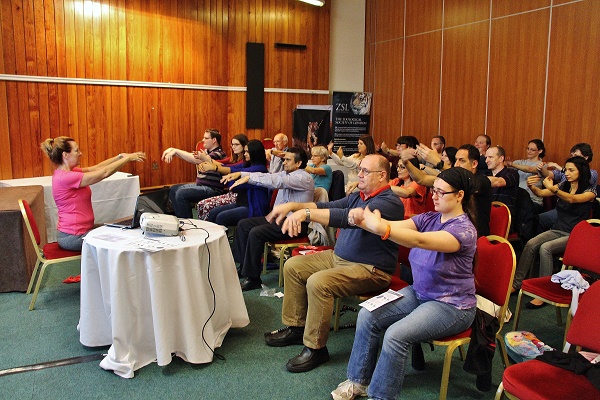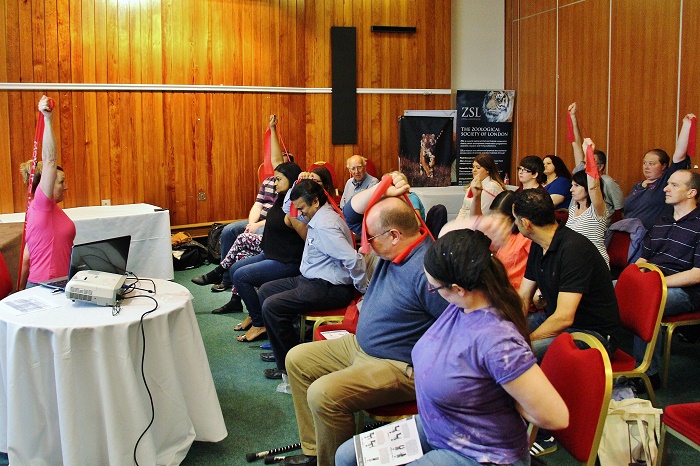In June we held our 5th Patient Workshop at London Zoo. As I’m sure those of you who attended can recall, the day included a chair-based exercise session. Following the success of the workshop, Hannah, our Patient Support Manager, recently attended a four day course to become a chair-based exercise instructor.
Why Chair-Based?
Many people with AKU stop regular exercise because of problems with pain and joint mobility. ‘Normal’ exercise classes in leisure centres are not always suitable for someone with AKU, and many sports are too high impact.

The aim of chair-based exercise is to re-introduce people to exercise, encourage them to exercise more regularly, and allow them to maintain independence despite their joint and mobility problems. Many of you struggle to access suitable exercise sessions in your local area, so having an exercise routine simple enough to take away with you, and continue in your own homes, is paramount.
The Course
The course to become an instructor is a VCTC Level 2 Award in delivering chair-based exercise. It is Ofqualaccredited, endorsed by the Centre for Healthy Ageing Research at Birmingham University, and includes the latest evidenced-based research from experts in active ageing.
The training was provided by ‘Move It or Lose It’, an organisation set up by Julie Robinson, a former PE teacher and now experienced exercise instructor. She has motivated thousands of people to keep active in later life, and has a network of instructors helping older people and those with disabilities across the UK.
The 4 day course was spread over a 2-3 week period and included classroom tuition, some home learning, and practical assessment. The aim for participants is to be able to plan, prepare, and deliver safe chair-based exercise sessions at the end of it.
Importance of Exercise
NICE (National Institute for Health & Care Excellence) publish clinical guidelines on how healthcare and other professionals should care for people with specific conditions. In June 2015 they published guidance on osteoarthritis which included a section on exercise. In these guidelines they stated adults with osteoarthritis are advised to participate in muscle strengthening and aerobic exercise. The rationale for this statement,
‘…exercise is a core treatment for osteoarthritis that will improve joint pain and function. It is important that people are advised to undertake specific exercise that is relevant for their condition, including muscle strengthening that targets affected joints and general aerobic exercise.’
AKU results in brittle bones and cartilage, early onset osteoarthritis with painful joints, and reduced mobility. It is recommended you avoid exercise which puts additional strain on the joints, but this does not mean you should avoid exercise completely. Exercise is considered to be an effective non-drug treatment for reducing pain and improving movement in osteoarthritis.
It is important to keep your joints moving, and get the right balance between rest and exercise. Too little activity can make your joints stiffen, whilst intense exercise can lead to increased pain. Aerobic exercise aims to improve general mobility, function, cardiovascular fitness, wellbeing and self efficacy, and could include cycling, swimming or exercise at a gym.
Chair based-exercise is a great way for anyone with AKU to participate in aerobic exercise, even if you have reduced mobility in the joints, or have had a joint replacement. All the exercises have adaptations depending on your own ability.
Getting Qualified
12 people from various parts of the country and backgrounds started the course, including a Dementia Support Worker, Activities Assistant, Supported Living Manager, University student and Dance Teacher.

Prior to the start of the course, we had to complete three worksheets on ‘Understanding the value of chair-based exercise with older adults’; ‘Planning and delivering chair-based exercise for older adults’ and; ‘Introduction to the values and principles of adult social care’.
For much of the course, the emphasis was about the practical delivery of safe seated exercise underpinned by a knowledge of how to demonstrate these exercises effectively. There was plenty of opportunity to put what we learnt into practice, as we all took it in turns to demonstrate the exercises and instruct other group members.
On the final day, we each had to plan an exercise session for our practical assessment. We were all quite nervous about the practical assessment, but at the end of it our apprehension was completely unfounded. Julie and Beth, our trainers from Move it or Lose It, gave us all the training and tools we needed to adequately prepare us for the assessment, and I’m pleased to say we all passed.
What Next For Patients?
Now a qualified chair-based exercise instructor, the plan is for Hannah to take a session at all our future patient workshops. She will also offer 1-1 sessions at home support visits.

Last week Hannah did her first 1-1 session whilst on a home support visit to Ann, one of the patients who attends the National AKU Centre. Ann found the visit really helpful, and especially enjoyed the chair-based exercise session. The session taught her exercises to do at her own pace in the comfort of her home. This may help to increase or maintain her independence, help with strength and balance, and most importantly, aid with activities of daily living. Ann is also now motivated to look for similar exercise classes in her local area.
Our next patient workshop is not until 20th April 2016, when we are planning our International Workshop to be held in Liverpool. Hannah will be holding a chair-based exercise session on the day and hopes to have a few small exercise sessions at a number of venues before then, as well as offering 1-1 sessions on home visits for any of our patients who would like one.
If anyone wants to find out more about chair-based exercise, how to find classes near you, or to discuss a 1-1 session during a home visit, please contact [email protected]
